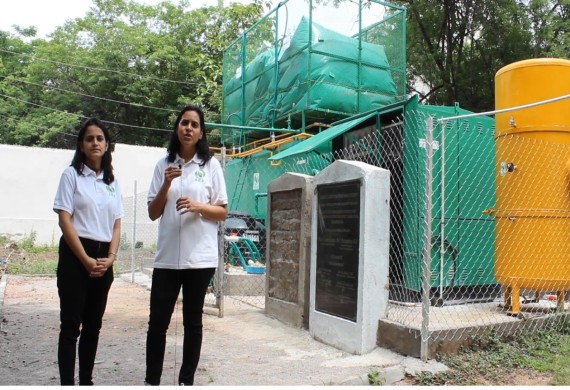
This Women-led Firm is Making Waste-to-Energy Conversion Simple
By: Navyasri, Writer, Womenentrepreneurindia
Did you know that the food waste market is ideal for biogas plants since the same waste generator can use the biogas to replace LPG in the kitchen? Since 2015, the hyderabad based entreprenuer Shruti Ahuja has been implementing this High-Rate Biomethanation technology, which turns organic waste into biogas and biofertilizer at various scales across India. Years later, she was joined by her sister Dr. Disha Ahuja. They've created biogas plants using cutting-edge technology and engineering in order to deliver a clean, odor-free operation that turns waste into energy efficiently.
"We've both returned from our post-graduate studies in the United States. Shruti got her master's degree and I received my doctorate, but we were yearning to return to our homeland and make a meaningful contribution to society. We have that in the waste to energy area, and we expect that government policy will promote the required change so that more people establish such plants. In our fight against global warming, we aim to make a dent "Dr. Disha Ahuja says.
Around ten years ago, this sister duo came across poultry waste, which is still a major disposal issue today. With their own capital, they started a 1 tpd pilot plant to process poultry manure.
"Since the same anaerobic technology is used to treat all types of organic waste, such as food waste, poultry litter, animal dung, vegetable waste, and so on, we were able to translate our digestors to handle food waste," explains Dr. Disha Ahuja.
Approximately one-third of the food we produce each year is never consumed. For every meal prepared, some food is left unfinished and goes in the bin. Food waste or loss can occur at any point in the food supply chain, including during production, processing, distribution, retail and food service sales, and consumption. Have you ever wondered where this waste ends up? It is disposed of in open landfills.
“Reducing organic waste landfills is one of the most important steps toward making our communities more sustainable and environmentally safe for future generations," the sisters add.
From an environmental perspective, food waste results in the use of chemicals such as fertilisers and pesticides, more fuel is used for transportation. Furthermore, the more food that rots in landfills, the more methane gases are produced, which is one of the most harmful greenhouse gases that contributes to global warming and climate change. Having these kinds of landfills close to our cities means welcoming problems into our lives.
Ahuja Engineering Services Pvt. Ltd. has licensed the biomethanation technology from CSIR-IICT (Indian Institute of Chemical Technology), Hyd. Their line of products consists of factory-made, plug-and-play solutions that have been customised to treat kitchen waste. The generated biogas is cleaned and piped back to the respective kitchens to replace LPG. Another application of biogas is power generation, which is typically carried out at a scale of 5000kg and above. In 2017, the company was awarded the renowned FTAPCCI excellence award for new and renewable energy development, as well as the US-Indo PACESETTER grant award for the commercialization of off-grid clean energy products in 2016.
Conversion of trash to energy
“Approximately 20-30% of organic waste can be scientifically treated at the source of origin, eliminating the need to carry or transport it to a landfill. To name a few, vegetable market yards, large hotel and restaurant chains, temples and gurudwaras, mid-day meal organisations, huge campuses and institutions, organised slaughter facilities, and meat exporting companies can all treat their food and vegetable waste on-site,” explains Shruti Ahuja. Slaughterhouses also produce animal manure, which can be converted into biogas and utilised to supplement their heating needs.
Both energy and resources are conserved at AES. AES uses T3 Trash to Treasure to replace waste-carrying vehicles with state-of-the-art anaerobic digestion plants. Food and vegetable waste are converted into fuel using the T3 digesters. This on-site trash manager can be used by any hotel, hospital, institute, company, temple, or any other facility with a large kitchen. Every day, load your waste into the system, and the system will take care of the rest. T3 has a one-of-a-kind design that produces a controlled environment for optimal waste-to-energy conversion.
The waste is loaded into a system where it is shredded and pre-processed in a buffer tank before being fed to the bacteria in the digester. This process yields biogas and biofertilizer from waste. “You can pipe the biogas directly into your kitchen and use it as a cooking fuel, directly replacing LPG,” adds Dr. Disha. The digested slurry can also be used as a biofertilizer in garden or landscape area. The benefits of T3 include the replacement of LPG with clean biogas, which lowers costs, aids in the maintenance of hygiene and sanitation, and improves sustainability.
Technology-Induced Changes
Almost 10 tonnes of garbage gathered every day at the Bowenpally market, which was before useless and would have ended up in landfills, is now giving people's lives meaning. Almost every ounce of vegetable, fruit, and even flower trash gathered at the market is now used to produce 500 units of power and 30 kg of biofuel. Over 100 streetlights, 170 stalls, an administrative building, and the water supply network are all lit by the electricity generated. Meanwhile, the biofuel produced is piped into the market's canteen kitchen. This plant in bownepalli was highlighted as a model plant by PM Modiji in mann ki baat in 2021.
“Also, I'd like to draw attention to the fact that we just established a plant in Bhadrachalam temple, Telangana, to handle mixed waste, including cow dung from their gowshala, food trash from their kitchen, and floral waste from their shrine. It's a collaboration between ITC Mission Sunehra Kal and Wash Institute,” says, Dr. Disha Ahuja.
Shruti's company signed a deal with the Akshaya Patra Foundation in 2014 to install a waste-to-biogas plant in Bellary, Karnataka. The unit has a daily capacity of 1,000 kilos of waste conversion. It can generate up to 140 cubic metres of biogas every day, which is the equivalent of 60 kg of LPG or four cylinders. The Akshaya Patra Foundation is notable for its pan-India mid-day meal programmes, which serve 1.3 million children every day across 10,000 schools.
The trash-to-energy system was used by the Kurnool Agricultural Market Committee in Andhra Pradesh in 2018 to cope with tonnes of waste created in the wholesale market. In the Kurnool market, the government committee has a canteen that serves lunch to farmers who come from far away to sell their produce.
This technology is also used at the CVR College of Engineering, the Osmania University Campus, the Capgemini Campus, and the CSIR-IICT, among other places.
Social Benefits of biogas plants
- Sanitation and Hygiene
The processing of organic waste in biogas systems has improved hygienic conditions on the individual campuses/locations of installation. The majority of these locations are in the heart of the city, surrounded by residential and commercial areas. In contrast to the former arrangement, where waste was collected and put inside the site and removed once every two or three days by the municipality, biogas installations provide immediate and regular waste disposal. Since biogas slurry and process do not attract flies or other vermin, the risk of communicable diseases spreading to humans and animals is reduced.
- Creation of new jobs
Each plant with a capacity of 100 to 500 kg/day requires one semi-skilled worker to run it. Manpower is being encouraged to conduct other activities such as pH checks, App-based reporting and monitoring of parameters, and other maintenance tasks in addition to their usual duties to broaden their skill set.
Commenting on the employment, Shruti says, "Each plant with a capacity of 5 to 10 TPD requires 5 to 6 unskilled and 8 to 10 semi-skilled workers, respectively. We've been able to hire and train the majority of unskilled female workers to do daily tasks under the supervision of skilled operators."
- Savings on LPG
Biogas systems have resulted in the continuous availability of cooking energy in canteens/kitchens as long as organic waste is provided.
Every year, India generates 62 million tonnes of municipal solid waste, of which 75 percent is collected. Only 20% of the waste collected is treated. Approximately 80% of this waste is eventually disposed of in landfills, contributing significantly to environmental degradation and posing risks to human health. Even in neglected fields like waste management, brilliant minds like Dr. Disha and Shruti Ahuja can make a world of difference.






